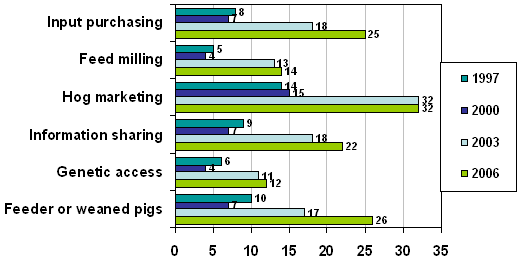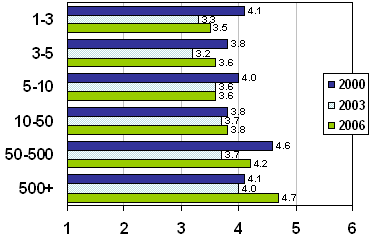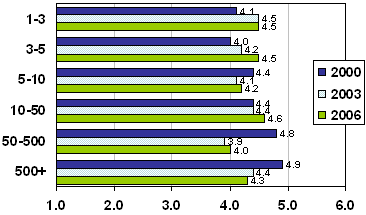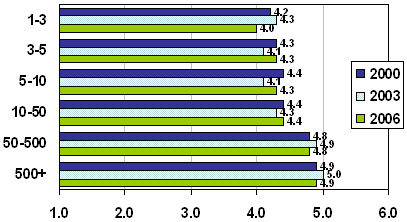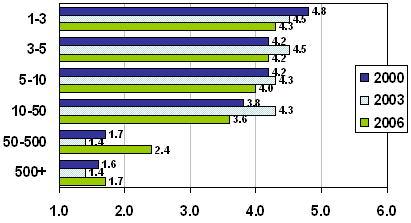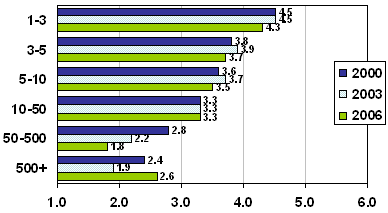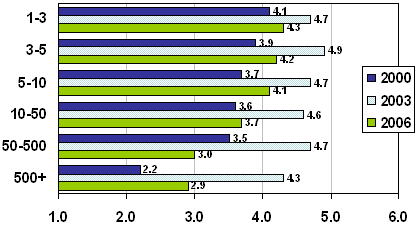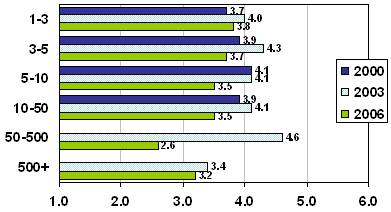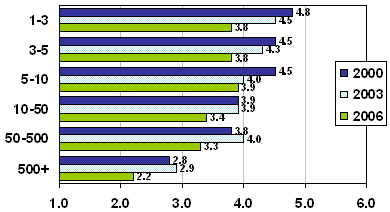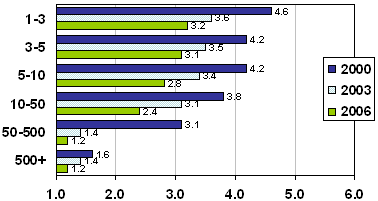|
of U.S. Pork Producers, 2006 Dept. of Agricultural Economics Working Paper No. AEWP 2007-5
The authors wish to thank Pork Magazine, National Pork Board, Pig Improvement Company, and the many producers who responded to the survey. We also wish to thank Ron Plain, Professor of Agricultural Economics, University of Missouri, for his review of the questionnaire and manuscript.
The U.S. pork production sector has changed dramatically in recent years. Two decades ago it was made up of hundreds of thousands hog enterprises often part of diversified farming operations. Today, ownership of hogs is concentrated in fewer firms which may contract with crop farmers such that production may still occur as part of a crop and livestock farm. Advances in production technology and changes in consumer preferences are credited as the driving forces behind the rapid evolution on the pork industry. Yet, innovative entrepreneurial pork producers are the ones who have made the changes occur. Researchers at the University of Missouri, and more recently Iowa State University, have chronicled pork industry changes for over 30 years. With the help of PORK magazine, the National Pork Board, Pig Improvement Company and the hundreds of producers who responded to the survey, we have taken a snapshot for the year 2006. In February and March of 2007, pork producers were surveyed regarding pork production and marketing practices during 2006 and production plans for 2007 through 2009. One survey was mailed to 5,040 pork producing operations marketing between 3,000 and 50,000 hogs annually. This sample was based on PORK Magazine's mailing list, with a random sample drawn from three size categories of producers according to their reported annual market volume. The survey was also mailed to approximately 1,200 producers on the National Pork Board's (NPB) mailing list who were classified as marketing between 1,000-3,000 hogs per year. Approximately 15 percent of the mail surveys were returned. In total, there were 903 usable responses from the combined PORK Magazine and NPB lists. Of the usable responses, 670 were owner-operators and 233 were contract growers. Producers on a third survey list of 179 operations marketing 50,000 or more hogs a year were contacted by telephone. The list was obtained from earlier surveys, personal contacts, and input suppliers to these large firms. If the producers confirmed marketing over 50,000 hogs annually, they were faxed a survey and returned it by fax. In total, 124 of these producers responded to the survey. It should be noted that the tables and figures created from this data were separated by owner-operator and contract grower responses. The contract grower data was used to create the tables and figures in the "Production Contracts" section. Structural Changes Table 1 shows the estimated number of US hog operations in 2006 and their market share by size category. These estimates were based on ownership of the hogs rather than individual farms with hogs. The total number of operations, (56,350) was based on USDA's reported number of owner operators. This number is down approximately 20% from 2003 when our previous survey was taken. The number of operations in the two largest size categories was based on personal knowledge and industry mailing lists. The number of firms in the remaining size categories was based on USDA estimates of the number of farms with hogs. USDA reports size of operations by inventory rather than marketings so we made adjustments to estimate an annual marketing number to match with the survey responses. The estimate of market share by size category was based on the survey responses for the average marketings per firm of each size and the number of firms. It was estimated that 27 operations marketing at least 500,000 hogs a year sold 43% of US hogs in 2006. The next size, 164 operations marketing between 50 and 500 thousand hogs a year, sold 21% of US hogs. Another 21% were marketed by 1,450 firms with annual sales of 10-50 thousand head. The remaining 15% of hogs were sold by firms marketing less than 10,000 hogs a year.
The number and size of pork producing firms has changed dramatically since the late 1980s (Table 2). In 1988 annual slaughter was approximately 87.8 million head and USDA estimated that there were 323,000 farms with hogs. It was estimated that nearly one-third (32%) of these hogs were produced by farms selling less than 1,000 head a year and only 7% were from those marketing over 50,000 annually. In 2006 US hog production totaled nearly 102 million head, 14 million more hogs than 1988, with 80% fewer farms with hogs. Approximately 1% of hogs were produced by farms marketing less than 1,000 head while 65% of hogs were produced by farms marketing over 50,000 head annually. The shift of market share occurred throughout the 1990s and continued through 2006. A big shift to larger farms occurred between 1994 and 1997 during the time of higher feed costs in 1995 and 1996. The market share of the under-1,000-head farms fell by 12 percentage points and the market share of the over-50-thousand-head operations increased by 20 percentage points. The 2-3 and 3-5-thousand-head-marketed market share remained relatively stable through 1997, but declined in recent years. The share of the 5-10- thousand-head operations initially grew and then declined. Market share growth continued through 2006 for firms marketing over 10 thousand hogs annually. Table 3 chronicles the increase in the number and market share of the Large (50-500 thousand head marketed annually) and Very Large firms (over 500 thousand head marketed annually). These two size categories were identified separately beginning with the 1994 survey when they contained a total of 68 firms with a 17% market share. In 2006 there were 191 firms with a 65% market share.
The 2006 survey also identified hog ownership by type of owner as a measure of vertical integration in the pork industry (Table 4). As is reported by AMS, packers and processors are significant owners of the Large and Very Large hog production firms. Feed suppliers and veterinarians also have an ownership position as do foreign investors.
In general, smaller firms started producing hogs sooner than larger firms and a lower percentage of smaller farms started hog production in the last 20 years (Table 5). A slightly higher percentage of the Large and Very Large operations began after 1985 than before 1985. Interestingly, 37% and 24% of the Large and Very Large, respectively, started production after 1995 during a time of rapid technological advances in the industry.
Of the under-50-thousand-head firms that also produced other commodities, most raised corn, soybeans and to a lesser extent wheat (Table 7). Few farms had other livestock enterprises besides hogs, but beef cow herds and beef feedlots were more common than dairy herds and stocker cattle.
The under-50-thousand-head producers were also asked about their participation in networking activities. This question has been asked since 1997 and there has been an increase in networking activity in recent years (Figure 1). One third of the producers reported networking on hog marketing, a fourth networked on input purchasing and pig production, and over 20% shared information. Networking on feed milling and genetic access were used to a lesser extent. Figure 1. Networking Activities of Producers Marketing 1,000-50,000 Head Annually (Percent of Respondents)
The use of artificial insemination leveled off between 2003 and 2006 after posting significant gains in the late 1990s and early 2000s (Table 8). The percent of litters sired by AI increased with the size of the firm. With the exception of the Very Large producers most firms purchased the semen that they used (Table 9). There was a nearly equal distribution between those that collected their own and those that partly owned a boar stud.
In 2006, the percent of operations finishing Canadian-born pigs ranged from 4% to 16% with few of the smallest and largest operations finishing Canadian pigs (Table 10). How they were purchased, however, was different (Table 11). Spot market purchases of Canadian pigs were more common for farms marketing under 5,000 head. The Very Large producers buying Canadian pigs used marketing contracts exclusively to purchase them. The 5,000 to 50,000 head producers were about evenly split between spot market and contracts. The 50-500- thousand-head producers tended to use more marketing contracts
Profitability The 2004-2006 period was very profitable for pork producers with a high percentage of firms reporting that they made a profit in each of the years (Table 12). In general, 2005 was more profitable than the other two years and the percent of profitable firms increased with annual marketings. Satisfaction with production correlated closely with profitability. In 2000, 95% of the over-50-thousand-head producers reported being profitable (Lawrence and Grimes). In 2003, approximately half of the under-50-thousand-head producers reported a profit and less than one-fourth of the over-50-thousand-head producers were profitable (Boessen, Lawrence, and Grimes) and their satisfaction with hog production declined. Not surprisingly, given the profitability reported in Table 12 producers were generally satisfied with pork production in 2006 (Table 13).
Plans for the Future In each survey, respondents were asked about their current and planned marketings and their answers were summarized by size category. In the 2003 survey, producers were asked how many hogs they planned to sell in 2004, 2005 and 2006. The percentage change between years was compared to the actual change over that period (Table 14). In general, operations producing less than 10,000 hogs per year increased their marketings between 2003 and 2006 more than predicted. This was the pattern between earlier studies also.
Table 15 shows the planned increase in marketings from 2006 through 2009. Keep in mind that the survey was conducted in February and March of 2007. Corn futures for 2007 and 2008 in late February for most contracts were over $4.00 per bushel. Yet, all size categories were anticipating growth in 2007 of 1 to 5%. They all also were anticipating additional growth into 2009 and, with the exception of the largest and the smallest categories, growth at a more rapid pace in 2008-2009.
Not all firms reported they plan to expand in the future and those that do reported different strategies about how they plan to grow (Table 16). Over half of the under-10-thousand-head producers indicated that they do not plan to expand hog production, yet a relatively large group in each category plan the same or more marketings. More production through existing facilities and constructing new facilities were common answers for the over-500- thousand-head producers. The 50-500-thousand head producers also plan to build new facilities. Smaller producers reported they plan to use these strategies less often, but their percent of use was comparable to their growth plans.
Participants were asked to rate a series of issues (Table 17) as to the level of challenge that they pose to the US pork industry over the next 5 years where 1 = extremely serious to 6 = not serious. In general, smaller producers had lower levels of concerns than did larger producers particularly in regard to finding employees. Input purchasing, disease, productivity, and compliance were rated among the greatest challenges. Business organization, niche markets, and human health were less serious issues regardless of size.
Ultimately the ability of firms to expand depends on their profitability which is a function of their cost of production. In each survey over the years, producers were asked what hog prices they would need to stay in business for an additional three years given a particular corn price. While previous surveys used a $2.40/bu Central Iowa corn price, in light of the recent increase in grain prices the 2006 survey used a $3.00/bu Central Iowa corn price. Table 18 reports the percent of respondents by size category who said they would stay in business until 2009 with $3.00 corn over a range of hog prices. Adding across the row for a size group, note that less than half of the producers marketing less than 500 thousand hogs would continue to raise hogs if hog prices fell below $46/cwt liveweight. Seventy-five percent of the Very Large producers indicated that they would continue to produce at prices below $46/cwt.
Obviously, there is a balancing act between cost of production and price. At lower prices producers go out of business, reducing supplies. With lower supplies, prices increase and more producers stay in business. As with earlier surveys there was a wider range in cost of production among smaller producers, and the Very Large operations had a higher percentage of firms willing to produce at the lowest prices. As in previous studies, the 50-500-thousand-head operations had a narrower operating range where none could survive at hog prices below $40/cwt but 92% would remain at prices of $48/cwt. Marketing Marketing is a critical aspect of pork production and one where practices differ and opinions run strong. In general, the percent of hogs marketed on a carcass merit basis leveled off in 2006 and larger producers sold a higher percentage of their hogs on carcass basis than did smaller producers (Figure 2). How firms marketed and priced their hogs differed by size of operation (Table 19). A higher percentage of smaller operations marketed their hogs on a load-by-load basis, but they also marketed some hogs on a negotiated or group contract or through their own packing plant. The use of contracts, negotiated or group, increased with the size of the firm. Nearly 90% of the over-500-thousand-head operations reported using negotiated contracts and 42% of the producers in this group reported selling to their own packing plant. Figure 2. Percent of Hogs Sold on Carcass Merit Basis
In spite of the contracts and owning a packing plant, larger producers tended to sell to more packers than did smaller producers (Table 20). Producers marketing under 5,000 head of hogs a year sold over half of their hogs to one packer, but a small portion sold to four or more packers. Approximately 80% of the 5,000 to 50,000 head producers sold to one or two packers and a small portion sold to as many as six packers. Relatively few of the 50-500 thousand head producers sold to only one packer, more commonly selling to two or four packers. Finally, while 37% of the Very Large producers sold to only one packer, 21% sold to eight or more packers. In part, selling to multiple packers may be a result of geographic proximity to more packers by firms with multiple production sites.
The two most common methods used for pricing market hogs were marketing contracts using a formula price tied to hog prices and the spot market (Table 21). The majority of hogs (57%) were priced using a formula tied to hog prices. The Large and Very Large producers sold a higher percentage using formula pricing. Approximately 20% of all hogs were sold on the spot market with smaller producers selling a higher percentage of their hogs this way than large producers. Contracts with pricing based on a formula tied to futures market prices or meat prices represented 7% and 6% of hogs respectively. Other types of formula or window contracts were less common.
A higher percentage of hogs were reported sold on the spot market in this study than indicated by USDA's Mandatory Price Reporting data. One reason for this is that only top quality and weight barrows and gilts are included in the Mandatory Price Reporting data. In this study cull breeding animals and light weight barrows and gilts were included. Smaller producers reported more flexibility in choosing a marketing date for their hogs (Table 22). This flexibility decreased as annual marketings increased through the 50-500 thousand head category. Twenty-six percent of the Very Large producers reported being able to market at a desired weight rather than having a tightly scheduled pig flow. However, 68% and 53% of the Large and Very Large producers reported being on a tight marketing schedule compared to less than 30% for the under 50,000 head firms.
The majority of producers used futures markets at times to manage price risk for the hogs they sold (Table 23), but larger producers were more likely than small producers to use futures. Some producers of all sizes used marketing contracts tied to futures prices. Likewise, some producers in all size groups never used futures. The reasons given for not using futures and options on futures were relatively consistent across those who regularly don't use them (Table 24). These reasons included bad experience in the past, dislike of margin calls, option premium too high, and too complicated. Livestock Revenue Protection insurance addresses some of these issues by subsidizing the premium and simplifying the process.
Not only did the use of marketing contracts differ across producer size groups, but also opinions about their impact on market efficiency and prices. Figures 3 to 11 report the opinions of producers by size category for the surveys taken in 2000, 2003, and 2006. Refer to the discussion above about the profitability of the sector, but in general it was profitable in 2000 and 2006 and was not as profitable in 2003. Also, all of these figures report opinions on a scale of 1 to 6 where 1 = strongly disagree and 6 = strongly agree with the statement. While respondents were not allowed to chose a "middle" number in the scale, a rank of 3.5 in the following graphs would indicate the average of the opinions was neutral. As Figure 3 indicates, larger producers more so than smaller producers believe that marketing contracts play a role in coordinating slaughter. In general, there was more agreement with this statement in profitable years than in unprofitable years. When asked if they believe that they have been treated fairly in their marketing contract, smaller producers agreed more often in recent years, but larger producers agreed less in recent years (Figure 4.). In general, smaller producers agreed more strongly than larger producers with the statement. Figure 3. Opinions on Marketing Contracts: Help Coordinate Slaughter
Figure 4. Opinions on Marketing Contracts: Felt They Were Treated Fairly under Contract
When asked if they plan to continue using marketing contracts, all sizes of producers responded positively with a higher than average ranking (Figure 5). In spite of their lower ranking to the earlier question, larger producers responded more positively to this question than the smaller producers. When asked if marketing contracts should be more closely monitored by USDA an interesting trend developed (Figure 6). First, agreement with the statement declined with the number of annual marketings. Second, the level of agreement declined over time among the under 50,000 head producers, but increased, particularly since 2003, with the over 50,000 head producers. Producers' preference for marketing all of their hogs on the spot market declined in 2006 and has declined over time (Figure 7). Preference declined as producer size category increased. However, there was renewed interest in cash market sales by the Very Large producer category. Figure 5. Opinions on Marketing Contracts: Plan To Continue Marketing with a Contract
Figure 6. Opinions on Marketing Contracts: Should Be More Closely Monitored by USDA
Figure 7. Opinions on Marketing Contracts: Prefer To Market All Hogs on Cash Market
In Figure 8 we see a familiar year and size pattern in producers' responses to the statement "marketing contracts have caused lower cash hog prices." There was less agreement with this statement among larger producers compared to smaller producers. There was also less agreement in profitable years compared to less profitable years. One of the reasons why large producers indicate they do not get higher prices with a contract is because they sell a large percentage of their hogs under contracts that use pricing formulas tied to the spot market for hogs or meat. There was less agreement with the statement "producers with marketing contracts get higher prices for their hogs" (Figure 9). Smaller producers agreed with the statement more than larger producers, but there was less overall agreement. However, there was more agreement in 2003, an unprofitable year, than in 2000 or 2006. Participants were asked if they agreed with the statement "packers showed undue preference in offering contracts" (Figure 10). In general, there was more agreement among smaller producers than larger producers. However, there was a sharp decline in agreement across most size categories when comparing 2003 to 2006. A similar pattern is seen when asked if Congress should make marketing contracts illegal (Figure 11). More small producers agreed than large producers, but agreement with the statement has declined considerably over time. Figure 8. Opinions on Marketing Contracts: Have Caused Lower Cash Market Prices
Figure 9. Opinions on Marketing Contracts: Producers with Contracts Get Higher Prices
Figure 10. Opinions on Marketing Contracts: Packers Showed Undue Preference in Offering Contracts
Figure 11. Opinions on Marketing Contracts: Should Be Made Illegal
Contract Production Contract production of hogs has grown to become a significant portion of the industry, but it has leveled off over the last three years. According to our survey, in 2006 approximately 55% of the pigs farrowed in the US were produced by firms that produce some or all of their hogs under contract. Some of these firms' pigs were farrowed in company-owned facilities (not under contract) and some were farrowed by growers (under contract) in the growers' facilities. Of the US hogs finished in 2006, two-thirds were owned by firms that used production contracts (Table 25). Table 26 reports the estimated percent of hogs that were produced by growers under contract in the growers' facilities. For farrowing, it is estimated to be near 20% of US farrowings. For finished hogs it is estimated 46% of US market hogs.
The average length of production contracts increased among the Large and Very Large firms in 2006 compared to 2003 and was variable among the under-50,000-head producers depending on the type of contract (Table 27). The amount of training provided for contract growers increased with the size of the contractor firm, in part because they are willing to contract with less experienced growers (Table 28). Smaller contractors prefer to find experienced growers rather than provide training.
Contractors were asked about their plans for the future and approximately half expected to maintain about their same mix of contract and owned production (Table 29). Of the Very Large producers approximately half expected to increase contract production. However, a significant portion of the under-50,000 and 50-500-thousand- head producers expected to reduce contract production in the next five years.
At least part of these future plans may be a result of the level of satisfaction with contract production by the contractors (Table 30). The Very Large were more satisfied with contracting than were the other two size groups, but the difference was small. The contract growers were also asked about satisfaction with contract production and in general their answers were comparable to those of the contractors (Table 31). Grower satisfaction has been relatively stable over the survey years, but was a little higher in the unprofitable year of 2003 compared to the profitable years of 2000 and 2006.
Most of the contract growers responding to the survey began contracting between 1995 and 2005 (Table 32). This time coincided with the rapid growth of the Large and Very Large producers. Only 21% were contracting before 1995 and 4% began after 2005.
The vast majority (78%) of the contract growers planned to continue contracting with the same company when their contract expires (Table 33). One change between 2003 and 2006 was that more growers were interested in becoming independent producers in 2006. In 2003 there was more interest in switching companies. In fact, 41% of the contract growers surveyed had contracted with more than one firm (Table 34).
Summary and Conclusions The US pork industry continues to evolve and consolidate to fewer and larger production operations. Our survey conducted in 2006 revealed approximately 65% of US hog production was under the control of 191 operations marketing over 50,000 hogs annually. An additional 21% of the hogs were produced by 1,450 operations marketing 10-50 thousand head annually. In each year a survey was conducted there has been a size below which categories were losing market share. This size category has increased over time and in 2006 the line is at 10,000 head. Operations marketing at least 10,000 head gained market share between 2003 and 2006, and farms marketing less than 10,000 head lost market share. The three years since the last survey were profitable for pork production as a high percentage of firms in all size groups reported profits in 2004, 2005, and 2006. In 2006, all size groups anticipated increasing their production in 2007 and on to 2009. Thus, it appears that the supply of pork will continue to grow. Producers' perceived obstacles to growth depended on the size of the operation, but in 2006 there were some common themes. Animal disease, productivity and compliance issues were the greatest perceived challenges. Business organization and niche markets were of less concern. Hog marketing has changed over time and producers' attitudes toward marketing contracts have changed as well. In general, in 2006 smaller producers had more marketing flexibility about when they sell hogs and were more likely to use the spot market. Larger producers marketed more hogs on a formula contract tied to spot market hog prices and had less flexibility in choosing a market weight at which to sell hogs due to pig flow schedule. However, not all producers in a size category marketed the same way and there was substantial crossover. Larger producers marketed to more packers than did small producers and they were more likely to have used futures markets. Producers' attitudes toward marketing contacts change with size of operation. Smaller producers look less favorably on them than do larger producers. In general, there was less concern about marketing contracts in 2006 than there was in 2003. However, while the under-50-thousand-head producers had less concern than before, the over-50-thousand-head producers had more concerns about marketing contracts in 2006 than they did in 2003. In addition, the concerns appear to correlate with profitability of hog production. There was more concern about marketing contracts and less profitable conditions in 2003. The percent of hogs raised by contractors and the percent produced under production contracts did not change very much from 2003 to 2006. It is estimated that 20% of the pigs farrowed and 46% of the hogs finished were under production contracts in 2006. The farrowing share is comparable to 10 years ago, but the finish share is more than a 50% increase from 1997. Contract production is expected to increase in the coming years. Over half of the over-500-thousand-head producers responding in 2006 expect to increase contract production. A portion of the under-50-thousand and 50-500-thousand-head producers expect to reduce contract production, but on average it is expected to increase from these two size groups. Also, both the contractors and growers were generally satisfied with contract production in 2006, albeit slightly less satisfied than they were in 2003. The vast majority of growers expect to continue contract production when their contract expires, 78% with current contractor and 6% with another company. Fourteen percent of the growers expect to become independent producers at the end of their contracts. References Boessen, Christian, John Lawrence, and Glenn Grimes. Production and Marketing Characteristics of U.S. Pork Producers - 2003. Ag. Econ. Working Paper 2004-4, Agricultural Economics Department, University of Missouri-Columbia, June 2004. Lawrence, John, and Glenn Grimes. "Production and Marketing Characteristics of U.S. Pork Producers, 2000," Iowa State Economics Department Staff Paper #343, Iowa State University, August, 2001.
| |||||||||||||||||||||||||||||||||||||||||||||||||||||||||||||||||||||||||||||||||||||||||||||||||||||||||||||||||||||||||||||||||||||||||||||||||||||||||||||||||||||||||||||||||||||||||||||||||||||||||||||||||||||||||||||||||||||||||||||||||||||||||||||||||||||||||||||||||||||||||||||||||||||||||||||||||||||||||||||||||||||||||||||||||||||||||||||||||||||||||||||||||||||||||||||||||||||||||||||||||||||||||||||||||||||||||||||||||||||||||||||||||||||||||||||||||||||||||||||||||||||||||||||||||||||||||||||||||||||||||||||||||||||||||||||||||||||||||||||||||||||||||||||||||||||||||||||||||||||||||||||||||||||||||||||||||||||||||||||||||||||||||||||||||||||||||||||||||||||||||||||||||||||||||||||||||||||||||||||||||||||||||||||||||||||||||||||||||||||||||||||||||||||||||||||||||||||||||||||||||||||||||||||||||||||||||||||||||||||||||||||||||||||||||||||||||||||||||||||||||||||||||||||||||||||||||||||||||||||||||||||||||||||||||||||||||||||||||||||||||||||||||||||||||||||||||||||||||||||||
